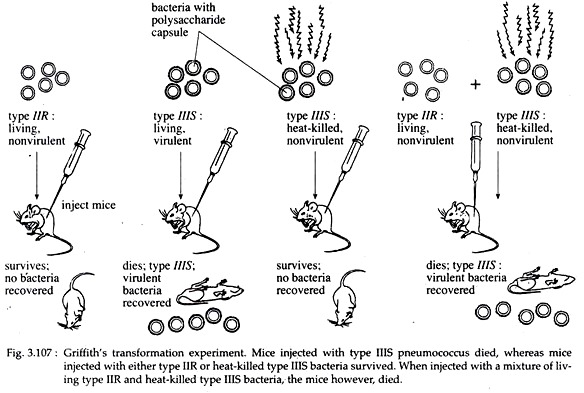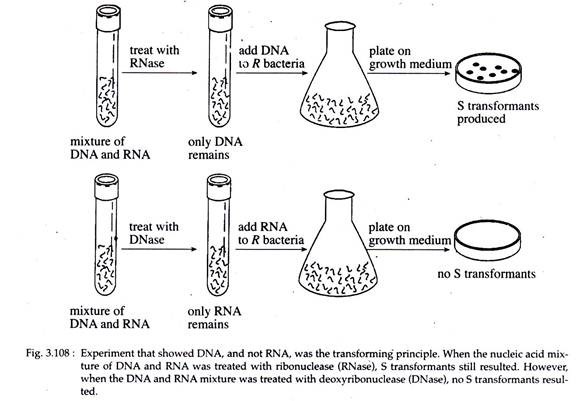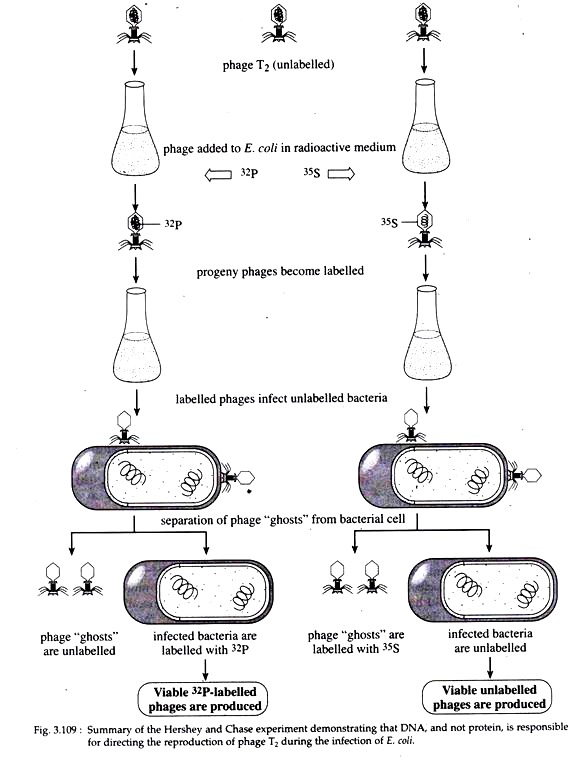The below mentioned article provides an overview on the Genetic Material:- 1. Introduction to Genetic Material 2. Characteristics of Genetic Material 3. Discovery of DNA 4. Transformation Studies 5. Nature of the Transforming Principle 6. The Hershey-Chase Bacteriophage-Experiment 7. Evidences Supporting the Concept.
Contents:
- Introduction to Genetic Material
- Characteristics of Genetic Material
- Discovery of DNA as Genetic Material
- Transformation Studies of Genetic Material
- Nature of the Transforming Principle
- The Hershey-Chase Bacteriophage-Experiment
- Evidences Supporting the Concept that DNA is the Genetic Material in Eukaryotes
1.
Introduction to Genetic Material:
One of the fundamental properties of all living things is the ability to reproduce. All organisms inherit the information specifying their structure and function from their parents. Likewise, all cells arise from pre-existing cells, and the genetic material must be replicated and passed from parent to progeny cells, at each cell division.
ADVERTISEMENTS:
The substance capable of carrying all biological and genetic information from one generation to another is called the genetic material. Long before DNA and RNA were proved to carry genetic information, geneticists recognized that specific molecules must fulfill that function.
2. Characteristics of Genetic Material:
They postulated that the material responsible for heritable traits would have to have the following principal characteristics:
i. Replicability:
ADVERTISEMENTS:
The genetic material of all cells must be replicated accurately so that progeny cells have the copies of same genetic information as the parental cell.
ii. Informative:
It must contain, in a stable form, the information for an organism’s structure, function, development and reproduction. This information must be transmitted from one to the next generation.
iii. Mutability:
ADVERTISEMENTS:
Though stable enough, the genetic material should be capable of undergoing variations (through mutation and recombination) in response to changes in environment and the demand of organic evolution.
Besides these characters, genetic material should be universal in its occurrence, i.e., it should be present in all organisms irrespective of its plant or animal origin and irrespective of its taxonomic position. The genetic material should be ‘stable’, i.e., it should not be destroyed by starvation. It should have molecular ‘integrity’, i.e., its chemical and physical structure should be same as in all cell types of an individual.
3. Discovery of DNA as Genetic Material:
Experiments performed by different scientists during mid to late 1,800s and the early 1,900s, suspected that genetic material was composed of proteins. Chemical analysis over the first 40 years of the last century, revealed that nucleus contained a unique molecule, the DNA.
However, it was not understood that DNA was the chemical constituent of genes, rather it was believed to be a molecular framework for a theoretical class of special proteins that carried genetic information.
Evidences gathered from experiments in the middle of the last century showed unequivocally that the genetic material of living organisms and many viruses consisted, not of protein, but of double-stranded DNA. In other viruses it may be single-stranded DNA and double or single- stranded RNA.
4. Transformation Studies of Genetic Material:
In 1928, Fredrick Griffith, a medical officer in the British Ministry of Health, performed experiments with several strains of the bacterium Diplococcus pneumoniae (Streptococcus pneumoniae). Some strains of this bacterium have polysaccharide coat surrounding each cell that gives a smooth, shiny appearance to the colony of the bacteria (S- type).
These bacteria are not easily engulfed and destroyed by the phagocytic cells in the animal’s circulatory system, and thereby are able to multiply and cause pneumonia. Thus, they are virulent. Whereas some other lack polysaccharide coat; colonies of this strain are non-shiny and rough (R-type).
ADVERTISEMENTS:
These non-capsulated bacteria are readily engulfed and destroyed by the phagocytic cells of circulatory system and so they are noninfectious and avirulent.
Each S-strains of Diplococcus can further be classified into different serotypes like IIS and HIS, on the basis of differences in chemical composition of the polysaccharide-coat constituent of the thick, shiny capsule. In his experiments, Griffith injected one batch of mice with R-bacteria, produced by mutation of type IIS bacteria.
Genetically these bacteria lacked the ability to make the polysaccharide coat i.e., any particular type of D. pneumoniae may occasionally give rise to bacteria that do not have capsules at all.
These R-bacteria did not affect the mice and after a while the bacteria disappeared from the animal’s blood stream. Griffith also injected another batch of mice with living type HIS bacteria. These mice died and living type HIS bacteria could be isolated from their blood.
Griffith further observed that if the type HIS bacteria were heat-killed before injection, the mice however, survived. Lastly, Griffith injected another batch of mice with a mixture of living R-bacteria (derived from IIS) and heat killed type IIIS bacteria. In this case, the mice died, and living IIIS bacteria were present in their blood (Fig. 3.107).
These bacteria could not have arisen by mutation of the R- bacteria, since mutation would have produced IIS colonies. Griffith then concluded that some R-bacteria had somehow been transformed into smooth, infectious type IIIS cells by interaction with the dead type IIIS cells.
The transformed cells retained their infectious properties and capsule type in successive generations, indicating that the transformation was stable. Griffith believed that the unknown agent responsible for the change or transformation in genetic material was a protein and he referred to it as the transforming principle.
5. Nature of the Transforming Principle:
In 1944, Oswald T. Avery, Colin M. Macleod and Maclyn McCarty showed that the transforming principle was not protein but was DNA instead. They performed an experiment in which transformation of bacteria R to S type was done in the test tubes.
They lysed IIIS cells and separated the lysate into different cellular macromolecular components like lipids, polysaccharides, proteins and nucleic acids. Each component then was checked whether or not it could transform living R bacteria derived from IIS into infectious type IIIS. It was found that only the nucleic acid component of IIIS type could transform the R cells into IIIS.
Avery et al. then digested those nucleic acid components with specific nuclease enzymes to determine whether DNA or RNA was the actual transforming principle.
When the nucleic acid was treated with ribonuclease (RNase), which digest RNA but not DNA, the transforming activity was still present. However, when de-oxy-ribonuclease (DNase) was used, no transformation resulted (Fig. 3.108). This result strongly suggested that DNA was the actual genetic material.
They further suggested that the DNA interacted with the IIR cell and gives rise to a coordinated series of enzymatic reaction culminating in the synthesis of the type IIIS capsular polysaccharide into the HR cells in successive generations.
Transformation is therefore, heritable and the process affects the genetic material or in other words, genetic material is capable of undergoing heritable change as stated in principal characters of genetic material. However, Avery’s work was criticized later on because the nucleic acids isolated from the bacteria by them was contaminated with some proteins.
6. The Hershey-Chase Bacteriophage-Experiment:
The second important evidence supporting DNA as the genetic material was provided by Alfred D. Hershey and Martha Chase in 1953. They were studying the replication of bacteriophage T2. At that time, it was known that T2 phage infect Escherichia coli first by attaching itself with its tail fibres, then injecting into the bacterium some genetic material which somehow controls the production of progeny T2 particles.
Finally, the bacterium is lysed, releasing 100 to 200 phages that could infect other bacteria. However, the nature of T2‘s genetic material was not known. Hershey and Chase grew E. coli cells in media containing either a radioactive isotope of phosphorus (32P) or sulphur (35S).
They used these isotopes because DNA contains phosphorus but no sulphur; so, 32P effectively labels DNA. On the other hand, protein contains sulphur but no phosphorus in their molecule; so, 35S labels proteins only.
This was the key point in the experiment. They first infected the bacteria with T2 phage and collected the progeny phages that were produced. At this point there were two batches of T2; one had the proteins labelled with 35S, and the other had the DNA labelled with 32P (Fig. 3.109).
It was known to them that each phage consisted of only DNA and protein, then they thought that one of these two molecules must be the genetic material.
To confirm the actual nature, they infected unlabeled E. coli, with the two types of radio labelled T2 Separately. In case of infection done by 32P labelled phages, most of the radioactivity could be found within the bacteria soon after infection.
Very little could be found in protein parts of the phage (phage ghost) released from the cell surface after mixing the cells in a blender. Following lysis, some 32P was also found in the progeny phages.
However, when E. coli was infected with 35S-labelled radioactivity virtually neither appeared within the cell nor in the progeny phages. But most radioactivity could be found in the phage ghosts after the blending treatment (Fig. 3.109).
Since it was DNA, not protein, that entered the cells, as evidenced by the presence of 32P and the absence of 35S in the progeny phages of the first case, Hershey and Chase interpreted that DNA must be the material responsible for function and multiplication of phage T2.
They hypothesized that the protein, form a structural framework to contain the DNA. Thus, Hershey and Chase proved that DNA is the genetic material in phages as it fulfilled the essential criteria like replicability (DNA was successfully replicated as well as transmitted in the progeny phages) and informative (DNA contained the necessary information for protein-coat synthesis as well as lysis).
Transfection Experiment:
More refined experiments in favour of DNA as the genetic material were reported by George Guthrie and Robert Sinsheimer in 1960. They purified DNA from the bacteriophage φ x 174, a small phage that contains a single stranded circular DNA.
They infected it with the E. coli protoplasts (enzymatically treated E. coli that contain only the cell membrane as their boundary). This process of infection by only the viral nucleic acid is called transfection.
Following transfection, the purified DNA resulted in the production of complete φ x 174 phages, which proved conclusively that φ x 174 alone contains all the necessary information for production of mature viruses; thereby establishing DNA as the genetic material.
7.
Evidences Supporting the Concept that DNA is the Genetic Material in Eukaryotes:
All the above mentioned evidences supporting the concept that DNA is the genetic material, thus far, had been obtained from prokaryotic cells (bacteria) and viruses. Subsequently, both direct and indirect evidences established unequivocally the central role of DNA in eukaryotic genetic processes.
Indirect Evidences – Distribution of DNA:
The genetic material generally should be found where it functions, i.e., in the nucleus as part of chromosome. However, both mitochondria and chloroplasts are known to perform genetic functions and DNA is also present in these organelles in addition to nucleus. Thus, DNA is found only where primary genetic function occurs.
Mutagenesis:
The molecules serving as genetic material are expected to absorb UV light at the wave-lengths found to be mutagenic. Both DNA and RNA absorb UV light most strongly at 260 nm, the wave-length where UV light is most mutagenic. Proteins absorb most strongly at 280 nm. These indirect evidences support nucleic acid to be the genetic material and tend to exclude proteins.
Direct Evidence – Recombinant DNA Studies:
In recombinant DNA technology, segments of eukaryotic DNA corresponding to specific gene are isolated and spliced into bacterial DNA. Such recombinant DNA can be inserted into bacterial cell and its genetic expression monitored. This experiment demonstrates directly that the recombinant DNA is not only present, but remains functional in the bacterial cell.
RNA as Genetic Material:
RNA is not reported as genetic material in any pro- and eukaryotes. However, some bacterial viruses (e.g., QB), some animal viruses (e.g., poliovirus) and some plant viruses (e.g., tobacco mosaic virus or TMV) have RNA as their genetic material — an exception to the general rule that DNA performs this function.
Like phage T2, TMV contains two chemical components – RNA and protein. In 1956, A. Gierer and G. Schramm showed that when tobacco plants were incubated with the purified RNA of TMV (i.e., RNA without protein coat), the plants develop virus-induced lesions.
However, no lesions were produced when the RNA had been degraded by treatment with ribonuclease and then injected into the plant. This result strongly indicated that RNA was the genetic material in TMV.


